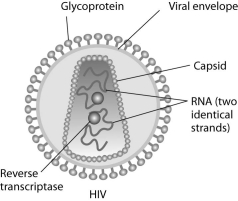Multiple Choice
Human immunodeficiency virus (HIV) infects cells that have both CD4 and CCR5 cell surface molecules. The viral nucleic acid molecules are enclosed in a protein capsid, and the protein capsid is itself contained inside an envelope consisting of a lipid bilayer membrane and viral glycoproteins. One hypothesis for viral entry into cells is that binding of HIV membrane glycoproteins to CD4 and CCR5 initiates fusion of the HIV membrane with the plasma membrane, releasing the viral capsid into the cytoplasm. An alternative hypothesis is that HIV gains entry into the cell via receptor-mediated endocytosis, and membrane fusion occurs in the endocytotic vesicle. To test these alternative hypotheses for HIV entry, researchers labeled the lipids on the HIV membrane with a red fluorescent dye.

-What would be observed by live-cell fluorescence microscopy if the red fluorescent lipid dye-labeled HIV membrane fuses with the target cell plasma membrane?
A) A spot of red fluorescence will remain on the infected cell's plasma membrane, marking the site of membrane fusion and HIV entry.
B) The red fluorescent dye-labeled lipids will diffuse in the infected cell's plasma membrane and become difficult to detect.
C) A spot of red fluorescence will move into the infected cell's cytoplasm.
D) A spot of red fluorescence will remain outside the cell after delivering the viral capsid.
E) Fluorescence microscopy does not have enough resolution to visualize fluorescently labeled HIV virus particles.
Correct Answer:

Verified
Correct Answer:
Verified
Q25: According to the fluid mosaic model of
Q26: Mammalian blood contains the equivalent of 0.15
Q27: Water passes quickly through cell membranes because<br>A)
Q28: Which of the following would likely move
Q29: What is the voltage across a membrane
Q31: The primary function of polysaccharides attached to
Q32: The sodium-potassium pump is called an electrogenic
Q33: Ions diffuse across membranes through specific ion
Q34: In most cells, there are electrochemical gradients
Q35: In a paramecium, cell surface integral membrane